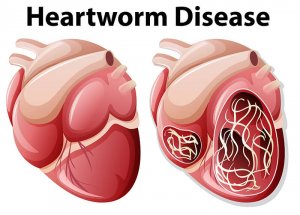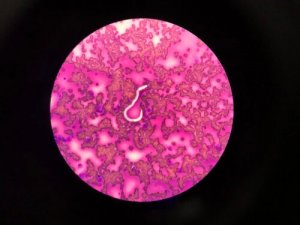What is Feline Filariasis?


Written and verified by the biologist Ana Díaz Maqueda
Feline filariasis (or heartworm disease) is fairly rare, and not much is known about the disease. This is due to a number of factors. Firstly, cats are not the primary host of heartworms. Plus, they rarely display symptoms, and any symptoms they do have are often misdiagnosed as other respiratory issues.
Because it’s a zoonotic disease, heartworms can be passed to humans and other pets, such as dogs. So, if you suspect your cat may be suffering from heartworm disease, you must seek help from your vet as soon as possible.
Types of heartworm
The term filariasis describes a group of mainly tropical diseases caused by roundworms. It’s a blood-born disease, spread by mosquitoes and other insects. In countries where heartworm disease is endemic, it often becomes chronic. Today, around 40 million people suffer from some type of chronic filariasis.
Adult roundworms can measure between 0.6 and 4 inches in length, while the larva measure no more than 340 micrometers, or 0.34 mm.
Heartworms are classified into different species, depending on the type of tissue the worms infect. Here are just a few examples:
- Lymphatic filariasis: Wuchereria bancroft and Brugia malayi worms infect the lymphatic system.
- Serous cavity filariasis is caused by the Mansonella perstands and ozzardi worms. These worms infect the membranes which protect the internal organs.
- Subcutaneous filariasis is caused by Mansonella streptocerca and Dracunculus medinensis worms.
- Loa Loa and Onchocerca volvulus are heartworms that infect the subcutaneous and connective tissues. Loa loa worms are also known as eyeworms.
- Dirofilaria immitis causes feline and canine filariasis, which infects the pulmonary arteries and heart tissue. Unlike other types of heartworm, dirofilaria can live in milder climates such as Southern Europe.

Dirofilaria
As we’ve already mentioned, heartworm disease is far more common in dogs than it is in cats. The infection rate in cats is roughly 5-20% of the rate in dogs in the same geographic location. In fact, even in places where the disease is endemic, the infection rate remains at around 10% of the feline population.
Just like in dogs, the term dirofilariasis refers to the presence of worms in the pulmonary and ventricular arteries. One of the main differences between canine and feline filariasis is that most cats only have one or two worms in their systems (although in severe cases they can carry up to 19 worms).
These worms normally only live two years inside their feline hosts. In dogs, they mature much more slowly, and have a lifespan of up to six years.
In general, cats also carry far fewer microfilaria – the larval form of heartworms – as their immune system is very good at fighting them. Studies have shown that only 20% of cats with heartworms have microfilariae in their blood.

Symptoms of feline filariasis
The majority of cats with dirofilaria are asymptomatic. However, when present, the signs of feline filariasis are fairly similar to those in dogs.
- Ascites or fluid in the abdomen
- Vascular edema
- Respiratory failure (dyspnea)
- Loss of appetite
- Apathy
- Dehydration
- Arrhythmia
- Heart failure
- Syncope
- Hemoglobinuria (dark colored urine)
Heartworm disease often causes sudden death, normally resulting from cardiorespiratory arrest. This may be due to a number of reasons, such as thrombus, caused by the build-up of dead worms in the arteries, or lesions on the heart or lungs.
Treatment of feline filariasis
Never treat your pet without a prescription from a vet. Feline filariasis requires different treatment to canine filariasis. The medication used to treat the disease in dogs is highly nephrotoxic and can kill your cat if administered incorrectly.
In general, a vet will prescribe your pet with bed-rest, along with corticoids to relieve symptoms. They may also prescribe additional medication if they believe the animal is at risk of heart failure.
Feline filariasis (or heartworm disease) is fairly rare, and not much is known about the disease. This is due to a number of factors. Firstly, cats are not the primary host of heartworms. Plus, they rarely display symptoms, and any symptoms they do have are often misdiagnosed as other respiratory issues.
Because it’s a zoonotic disease, heartworms can be passed to humans and other pets, such as dogs. So, if you suspect your cat may be suffering from heartworm disease, you must seek help from your vet as soon as possible.
Types of heartworm
The term filariasis describes a group of mainly tropical diseases caused by roundworms. It’s a blood-born disease, spread by mosquitoes and other insects. In countries where heartworm disease is endemic, it often becomes chronic. Today, around 40 million people suffer from some type of chronic filariasis.
Adult roundworms can measure between 0.6 and 4 inches in length, while the larva measure no more than 340 micrometers, or 0.34 mm.
Heartworms are classified into different species, depending on the type of tissue the worms infect. Here are just a few examples:
- Lymphatic filariasis: Wuchereria bancroft and Brugia malayi worms infect the lymphatic system.
- Serous cavity filariasis is caused by the Mansonella perstands and ozzardi worms. These worms infect the membranes which protect the internal organs.
- Subcutaneous filariasis is caused by Mansonella streptocerca and Dracunculus medinensis worms.
- Loa Loa and Onchocerca volvulus are heartworms that infect the subcutaneous and connective tissues. Loa loa worms are also known as eyeworms.
- Dirofilaria immitis causes feline and canine filariasis, which infects the pulmonary arteries and heart tissue. Unlike other types of heartworm, dirofilaria can live in milder climates such as Southern Europe.

Dirofilaria
As we’ve already mentioned, heartworm disease is far more common in dogs than it is in cats. The infection rate in cats is roughly 5-20% of the rate in dogs in the same geographic location. In fact, even in places where the disease is endemic, the infection rate remains at around 10% of the feline population.
Just like in dogs, the term dirofilariasis refers to the presence of worms in the pulmonary and ventricular arteries. One of the main differences between canine and feline filariasis is that most cats only have one or two worms in their systems (although in severe cases they can carry up to 19 worms).
These worms normally only live two years inside their feline hosts. In dogs, they mature much more slowly, and have a lifespan of up to six years.
In general, cats also carry far fewer microfilaria – the larval form of heartworms – as their immune system is very good at fighting them. Studies have shown that only 20% of cats with heartworms have microfilariae in their blood.

Symptoms of feline filariasis
The majority of cats with dirofilaria are asymptomatic. However, when present, the signs of feline filariasis are fairly similar to those in dogs.
- Ascites or fluid in the abdomen
- Vascular edema
- Respiratory failure (dyspnea)
- Loss of appetite
- Apathy
- Dehydration
- Arrhythmia
- Heart failure
- Syncope
- Hemoglobinuria (dark colored urine)
Heartworm disease often causes sudden death, normally resulting from cardiorespiratory arrest. This may be due to a number of reasons, such as thrombus, caused by the build-up of dead worms in the arteries, or lesions on the heart or lungs.
Treatment of feline filariasis
Never treat your pet without a prescription from a vet. Feline filariasis requires different treatment to canine filariasis. The medication used to treat the disease in dogs is highly nephrotoxic and can kill your cat if administered incorrectly.
In general, a vet will prescribe your pet with bed-rest, along with corticoids to relieve symptoms. They may also prescribe additional medication if they believe the animal is at risk of heart failure.
All cited sources were thoroughly reviewed by our team to ensure their quality, reliability, currency, and validity. The bibliography of this article was considered reliable and of academic or scientific accuracy.
- Altamirano Arias, E. I. (2019). Prevalencia de Microfilaria immitis en Felis silvestris catus atendidos en la Casa Comunal Ana María de Olmedo, Durán.
- Miller, M. W., Atkins, C. E., Stemme, K., Robertson-Plouch, C., & Guerrero, J. (2000). Prevalence of exposure to Dirofilaria immitis in cats in multiple areas of the United States. Vet Ther, 1(3), 169-75.
- Morchón, R., Carretón, E., González Miguel, J., & Mellado Hernández, I. (2012). Heartworm disease (Dirofilaria immitis) and their vectors in Europe–new distribution trends. Frontiers in physiology, 3, 196.
- Sánchez, J. P., del Valle Apastegui, R., Romero, M. B., & Santos, J. S. (2014). Nematodosis (I): filariasis. Medicine-Programa de Formación Médica Continuada Acreditado, 11(53), 3129-3141.
- Odriozola, V. M. V. (1995). Dirofilariasis en Gatos. Anuario AAMeFe.
- Palmieri, J. R., Masbar, S., Marwoto, H. A., Tirtokusumo, S., & Darwis, F. (1985). The domestic cat as a host for Brugian filariasis in South Kalimantan (Borneo), Indonesia. Journal of helminthology, 59(3), 277-281.
This text is provided for informational purposes only and does not replace consultation with a professional. If in doubt, consult your specialist.








